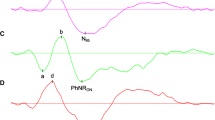Abstract
In pigeons, electroretinographic responses to contrast reversal of sinusoidal gratings (pattern ERGs) were recorded before and after section of the left optic nerve. Ninety and 270 days following optic nerve section the ganglion cell layer of the side that underwent the surgical procedure showed an 80% reduction in the number of cell bodies as compared with the intact side. At these times the pattern ERGs showed comparable amplitudes in both eyes. There is a possibility that the inner nuclear layer of the pigeon retina plays a major role in the generation of the pattern ERG.
Similar content being viewed by others
References
Bagnoli P, Porciatti V, Francesconi W and Barsellotti R (1984) Pigeon-pattern electro-retinogram: A response unaffected by chronic section of the optic nerve. Exp Brain Res 55:253–262
Bingelli RL and Paule WJ (1969) The pigeon retina: quantitative aspects of the optic nerve and ganglion cell layer. J Comp Neurol 137:1–18
Dawson WW andLieberman HR (1979) Evidence for two retinal control loops. In: Current Concepts in Ophthalmology, eds. Kaufman HE, Zimmerman TJ, St. Louis, Toronto, London, Mosby pp. 111–121
Ehrlich D (1981) Regional specialization of the chick retina as revealed by the size and density of neurons in the ganglion cell layer. J Comp Neurol 195:643–657
Fiorentini A, Maffei L, Pirchio M, Spinelli D and Porciatti V (1981) The ERG in response to alternating gratings in patients with diseases of the peripheral visual pathway. Invest Ophthalmol Vis Sci 21:490–493
Hayes BP and Holden AL (1980) Size classes of ganglion cells in the central yellow field of the pigeon retina. Exp Brain Res 39:269–275
Hebel R (1976) A method of preparing whole mounts of the retina for studies on ganglion cells. Mikroskopie 32:96–99
Holden AL and Vaegan (1982) Intraretinal responses to contrast reversal in the pigeon. J Physiol (Lond) 324:69P
Holden AL and Vaegan (1983) Vitreal and intraretinal responses to contrast reversing patterns in the pigeon eye. Vision Res 23:561–572
Holländer H, Bisti S, Maffei L and Hebel R (1984) Electroretinographic responses and retrograde changes of retinal morphology after intracranial optic nerve section. A quantitative analysis in the cat. Exp Brain Res 55:483–493
Hughes A (1975) A quantitative analysis of the cat retinal ganglion cell topography. J Comp Neurol 163:107–128
Madison R, Moore MR and Sidman RL (1984) Retinal ganglion cells and axons survive after optic nerve transection. Int Neurosci 23:15–32
Maffei L and Fiorentini A (1981) Electroretinographic responses to alternating gratings before and after section of the optic nerve. Science 211:953–955
Maffei L and Fiorentini A (1982) Electroretinographic responses to alternating gratings in the cat. Exp Brain Res 48:327–334
Maffei L, Fiorentini A, Bisti S and Holländer H (1985) Pattern ERG in the monkey after section of the optic nerve. Exp Brain Res 59:423–425
Miles FA (1975) Centrifugal control of the avian retina. I. Receptive field properties of retinal ganglion cells. Brain Res 48:65–92
Muchnick N and Hibbard E (1980) Avian retinal ganglion cell resistant to degeneration after optic nerve lesion. Exp Neurol 68:205–216
Nye PW (1968) An examination of the electroretinogram of the pigeon in response to stimuli of different intensity and wavelength and following intense chromatic adaptation. Vision Res 8:679–696
Porciatti V and von Berger GP (1985) Pattern ERG and VEP in optic nerve disease: early diagnosis and prognosis. Doc Ophthalmol Proc. Ser. 40:117–126
Richter A and Simon EJ (1975) Properties of centre-hyperpolarizing red-sensitive bipolar cells in the turtle retina. J Physiol (Lond) 248:317–334
Saito T, Kondo H and Toyoda J (1979) Ionic mechanisms of two types of on-center bipolar cells in the carp retina. I. The responses to central illumination. J Gen Physiol 73:73–90
Saito T, Kondo H and Toyoda J (1981) Ionic mechanisms of two types of on-center bipolar cells in the carp retina. II. The responses to annular illumination. J Gen Physiol 78:569–589
Saito T and Kujiraoka T (1982) Physiological and morphological identification of two types of on-center bipolar cells in the carp retina. J Comp Neurol 205:161–170
Spekreijse H, Estevez O and Van der Tweel LH (1973) Luminance responses to pattern reversal. Doc Ophthalmol Proc Ser 2:205–211
Wingstrand KG and Munk O (1965) The pecten oculi of the pigeon with particular regard to the function. Biol Skr Dan Videnskab Selskab 14:1–64
Wood CA (1917) The fundus oculi of birds. Chicago, Lakeside Press
Author information
Authors and Affiliations
Rights and permissions
About this article
Cite this article
Porciatti, V., Francesconi, W. & Bagnoli, P. The pigeon pattern electroretinogram is not affected by massive loss of cell bodies in the ganglion layer induced by chronic section of the optic nerve. Doc Ophthalmol 61, 41–47 (1985). https://doi.org/10.1007/BF00143214
Issue Date:
DOI: https://doi.org/10.1007/BF00143214




